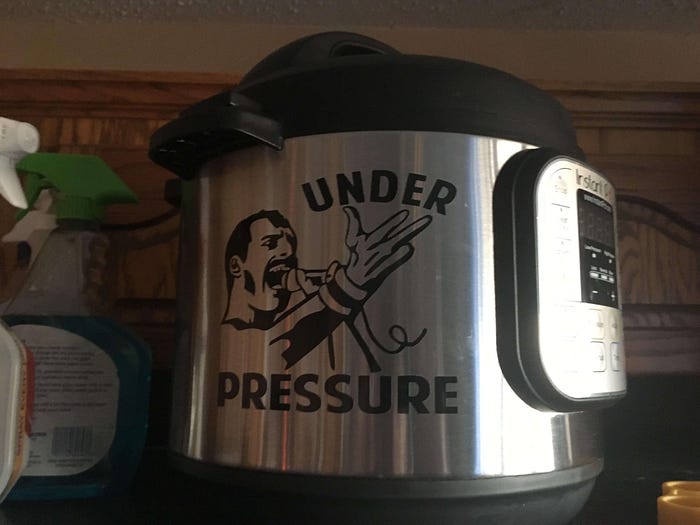Pressure Cookers are more pressurized than you can fathom
Enthusiasm is the steam that drives the engine- Napoleon Hill
Only recently did I get a respect for what water in its vapour form is capable of. For example, we see steam being used in the medical industry for sterilization(microorganisms can’t sustain such temperature and pressures). Or for running HUGE turbines that generate the electricity for our homes. Or several important chemical reactions, without which our lives would be something else.
Or the simple domestic pressure cooker. To take household cooking to a new league.
Well, before jumping into the role played in a pressure cooker, let’s understand why is high pressure steam so versatile.
Among the several desirable properties of pressurized steam, it has got a high enthalpy, it is non-toxic, and is abundant in nature(as water).

The Working of a Pressure Cooker
A pressure cooker utilizes water and steam under high pressure and temperature to achieve perfect cooking.
Try this- Heat water in an open vessel until it starts boiling. Measure the temperature of this water. You should expect between 90⁰–100⁰C.
Now try this(although I suggest not to)- Keep some water in a sealed cooker and heat it till the whistle starts blowing. Now, measure the temperature of this water(idk how you will). What do you observe?
When heated in an open vessel, water boils off at about 100⁰ C (at 1 atm). However, when we seal the container, the same water starts boiling at much higher temperatures(around 120⁰C). But why?
When we seal off the openings, there is almost no escape for the steam. As a result, it starts building up within the cooker. And quite logically, the pressure rises, sometimes to dangerous levels.
In an experiment conducted by CNN, an explosion sent shrapnel flying at supersonic speeds!
Higher pressure implies higher boiling points.
To understand this, lets get the idea of boiling. When you start heating water(or any other liquid), the temperature keeps increasing. Basically, you are supplying energy in the form of heat. But after a point, the water can’t take any more. So what happens?
It tries to break free.

In case of an open vessel, the weight of the atmosphere presses down on the water surface. But at near 100⁰C, the water gets enough energy to counteract this force.
It then gets converted into vapour and escapes.
That’s why you may have heard of the popular fact that water boils at lower temperatures at high altitudes. The weight of the air acting down on the surface is pretty low, and water can break free quite easily.
Now back to Pressure Cookers. When we seal the lid, what we are essentially doing is adding to the weight of the atmosphere acting down. Once water starts boiling inside the container, the vapour thus formed has no place to go! So it starts pressing everywhere around the cooker. And also onto the surface of the water. To get a sense of this, the pressure exerted by the steam is equal to the atmospheric pressure(about 103kPa gauge).
You can also think of it as 6 people standing on the lid of the cooker!
To overcome this, we need to supply MORE energy to break free. That happens at around 120⁰C.
Simply put- Higher temperatures ensure more energy at your disposal. The high pressure, high temperature steam(and water) penetrate into raw food, and do their magic. In the end all we see and devour is that tasty, cooked food.

The Whistle
While dealing with high pressures, one has to be extra considerate of the risk involved.
See how a pressure-cooker bomb works — YouTube
To ensure that safe pressure limits are not exceeded, engineers designed Pressure Relief Valves(aka Whistle) to keep check. Once pressure builds up inside the container, it lifts the whistle and manages to escape.
This way a constant, safe amount of pressure is maintained.

But what if, our whistle is jammed, or the exit route is clogged?
This calls for a safety/emergency relief valve situated on the lid itself. If the pressure builds up more than necessary, it breaks open this valve and escapes. The cooker gets damaged but you are safe.
Added Benefits
We have seen that steam plays the bigger role in a pressure cooker. Thus, with only a little water required to cook, these vessels can be used in areas of water scarcity.
The steam, being trapped inside a chamber, exerts force in all directions, even into the food. This ensures that food is cooked uniformly.
Finally, the energy consumption is reduced, as the steam is not allowed to escape quickly.
Isn’t it indeed a valuable asset in our domestic arsenal?